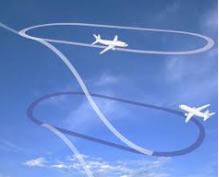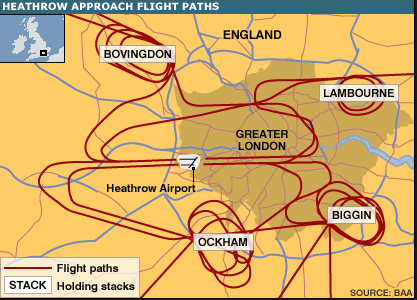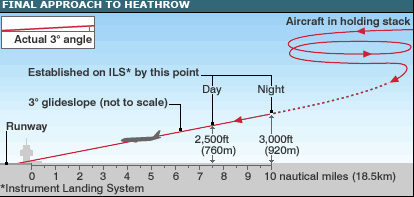Aircraft Holding
 The holding patterns are like a race track pattern over the navigation fix. The aircraft will turn either left and right 180 degrees [the direction is displayed on a chart] taking a minute to turn and roll out. It takes 4 minutes to get around the hold pattern once.
The holding patterns are like a race track pattern over the navigation fix. The aircraft will turn either left and right 180 degrees [the direction is displayed on a chart] taking a minute to turn and roll out. It takes 4 minutes to get around the hold pattern once. In order to land safely, air traffic controllers and pilots follow a set procedure. Pilots usually fly a standard arrival procedure (STAR) to the Holding pattern. In my 40+ year career, London Heathrow (LHR) was an aiport where I had to hold frequently to fit in with the busy early morning traffic. The London controllers were consistently briiliant throughouth out my career. The best in the world. I will use LHR as an example to better explain holding patterns.
 The landing sequence generally starts with incoming flights being directed to one of four holding patterns on the outskirts of London.
The landing sequence generally starts with incoming flights being directed to one of four holding patterns on the outskirts of London.
Within the stacks, the aircraft are kept 1,000 vertical feet (305m) apart and at least 7,000ft (2,133m) above the ground.
The number of stacks in use and the number of aircraft in each stack depends on how busy the airport is at the time and where the flights are coming in from. The four stacks used by Heathrow are located over navigation beacons at Bovingdon, Lambourne, Ockham and Biggin.
When air traffic control is ready for an aircraft to land, the pilot is instructed to move out of the holding pattern and begin the descent to the airport.
 The graphic displayed shows a typical arrival after a holding pattern. When cleared to leave a holding pattern the descent is normally continuous, keeping the engine power at idle, to keep jet plane noise to a minimum.
The graphic displayed shows a typical arrival after a holding pattern. When cleared to leave a holding pattern the descent is normally continuous, keeping the engine power at idle, to keep jet plane noise to a minimum.
Air Traffic Control instructs the pilots to fly their aircraft on certain headings to eventually line up with the landing runway, usually about 10nm out.
When air traffic control is ready for an aircraft to land, the pilot is instructed to move out of the holding pattern and begin the descent to the airport.
Cockpit view of holding pattern (Biggin Hill) on a clear London day. Aegean 602